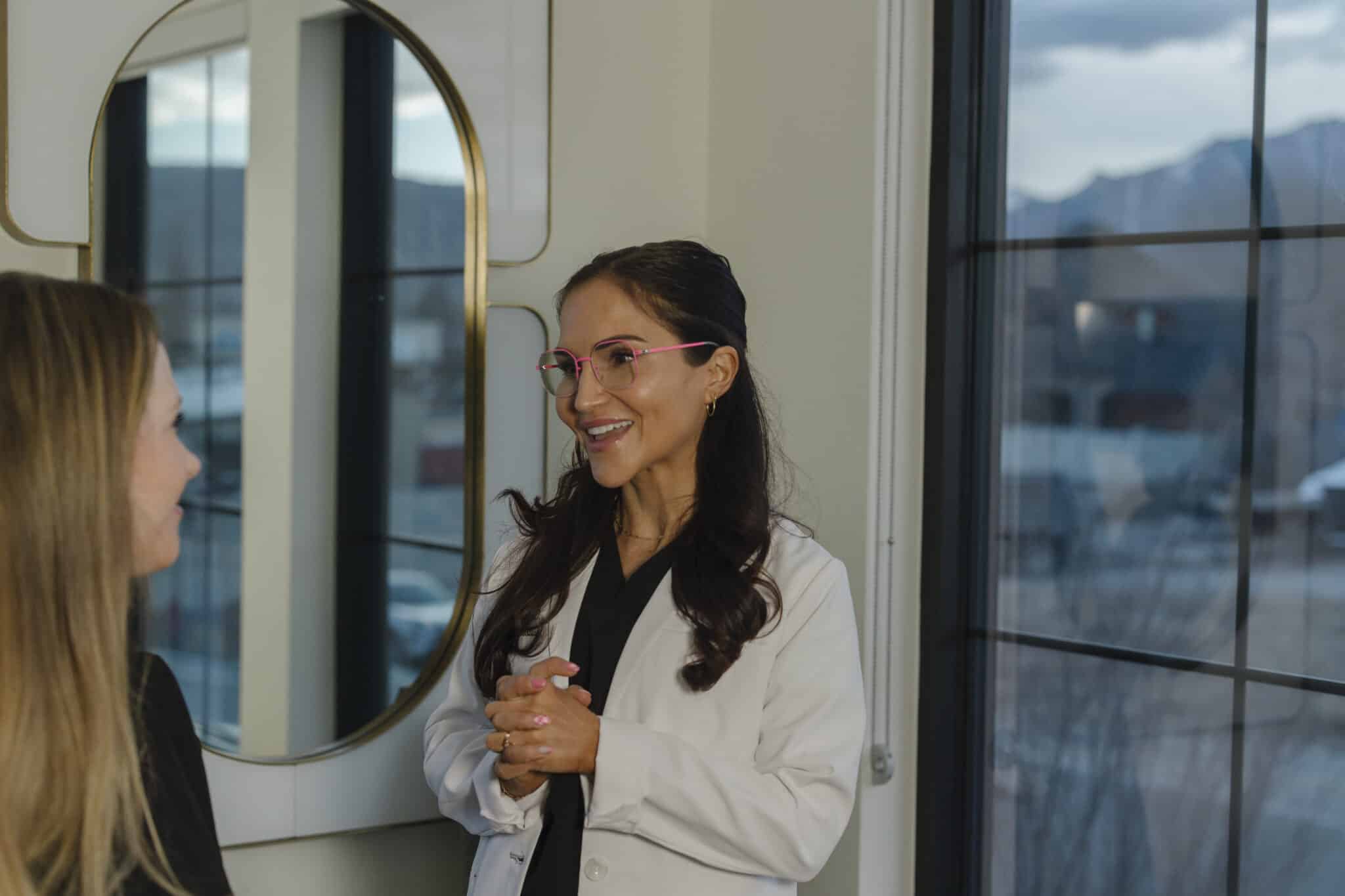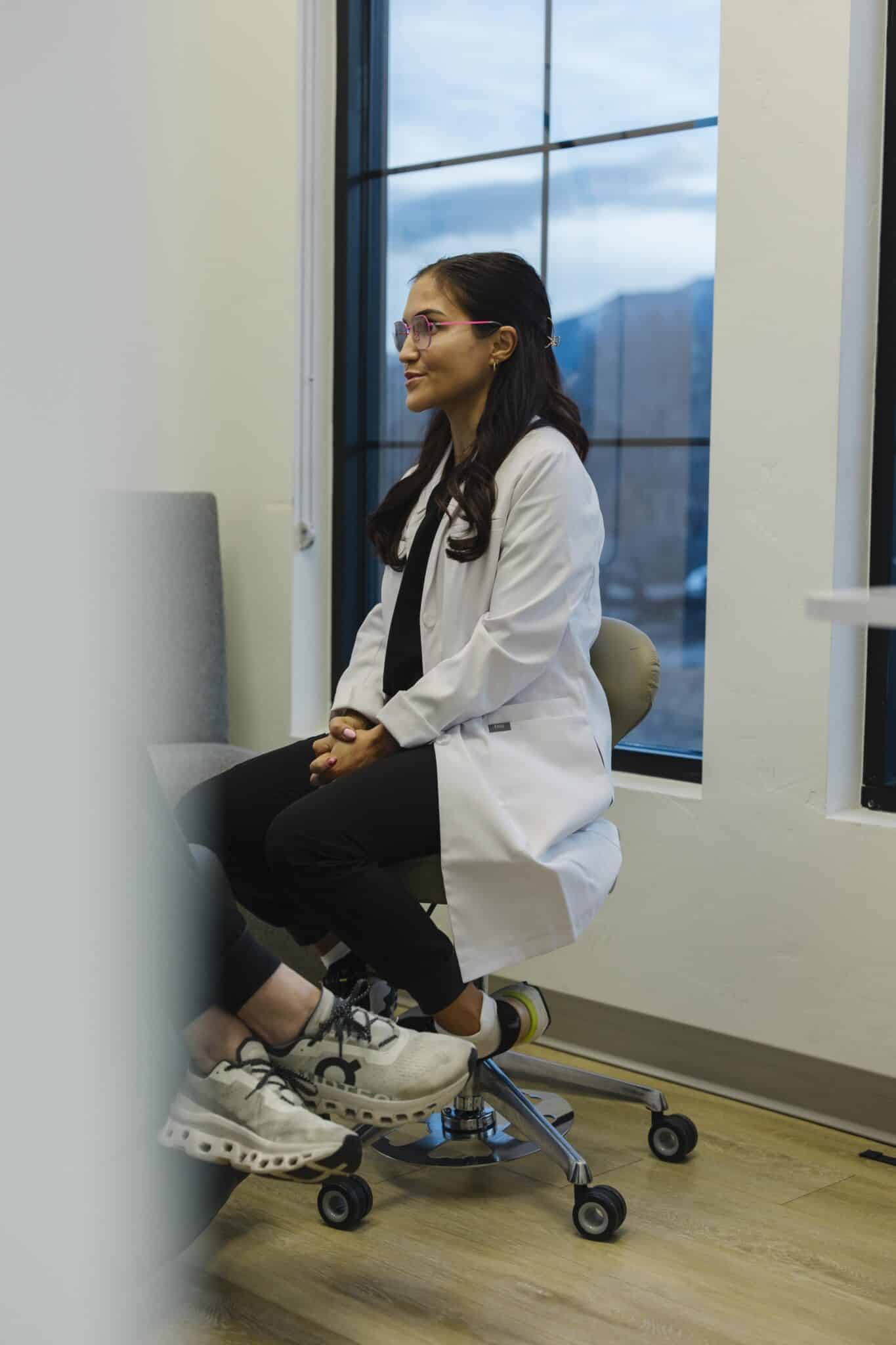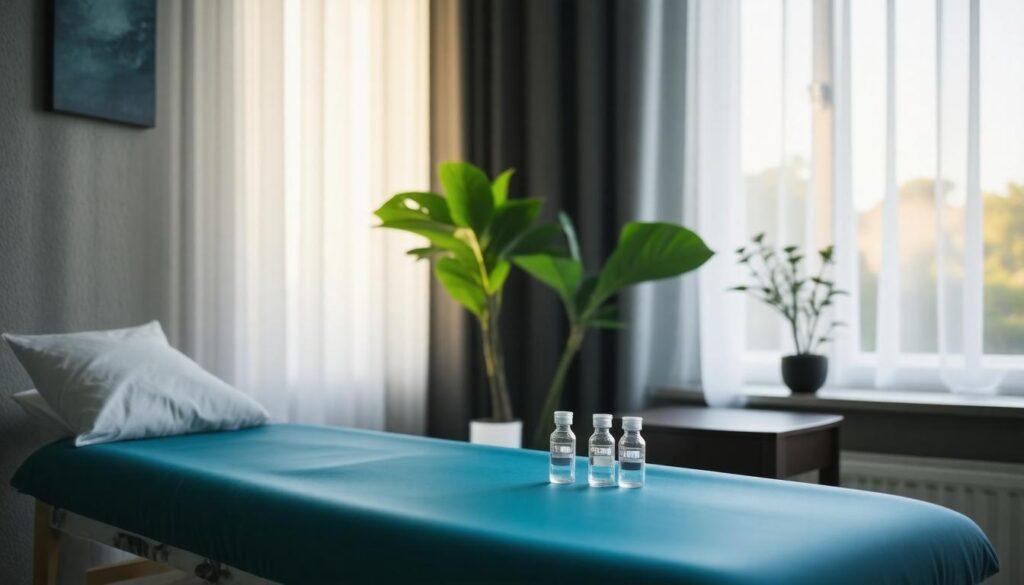In the quest for well-being, many people are navigating the often confusing world of hormone replacement options. Have you ever found yourself feeling off-balance, battling fatigue, mood swings, and other unwelcome changes? It’s not just you—these symptoms can stem from hormonal imbalances that most of us face at some point in life. That’s where Bioidentical Hormone Replacement Therapy, or BHRT, comes in. By using hormones that are identical in structure to those produced by our bodies, this therapy aims to help individuals regain that lost equilibrium and improve their quality of life. At Utah Facial Plastics, we believe lasting beauty starts from within, and our expert team is committed to helping you achieve optimal wellness and balance for a healthier, more confident life. Give us a call to get started at 385.410.4551 or contact us here, and enjoy learning more about the benefits of Bioidentical Hormone Therapy in the details below.
As we dive into the details of BHRT, you’ll discover how it works, the differences between bioidentical and synthetic hormones, and real stories of those who have embarked on this journey toward renewed wellness.
Bioidentical Hormone Replacement Therapy (BHRT) involves the use of hormones that are chemically identical to those produced by the human body to alleviate symptoms associated with hormonal imbalances or menopause. This therapy aims to restore hormonal balance through personalized treatment plans, often resulting in improved quality of life for individuals experiencing these issues.
What Are Bioidentical Hormones?
Bioidentical hormones are lab-created compounds designed to replicate the exact molecular structure of hormones that our bodies naturally produce. This technical detail has significant implications for how these hormones interact within the body. Unlike synthetic hormones, which can have slight variations in their chemical composition—possibly leading to unexpected side effects—bioidentical hormones are recognized by the body as if they were its very own. This means they can often provide more effective relief from hormonal imbalances with fewer adverse reactions.
You might be wondering why this matters so much. The answer lies in how our bodies perceive and utilize these substances. Because bioidentical hormones fit perfectly into our hormone receptors, they can restore balance more seamlessly than their synthetic counterparts. They can also be customized to meet individual needs, allowing healthcare providers to tailor treatments based on personal hormone levels.
Common examples of bioidentical hormones include estradiol, a form of estrogen; progesterone; and testosterone. These hormones are vital not only for reproductive health but also influence mood, energy levels, and overall well-being.
According to a 2024 study by the American Association of Endocrinologists, over 60% of patients seeking hormone therapy express a preference for bioidentical versions. This preference correlates strongly with experiences of efficacy and heightened satisfaction thanks to the perceived naturalness of these treatments compared to traditional synthetic alternatives.
As you explore bioidentical hormone replacement therapy, remember that individual experiences may vary widely. Some may find substantial relief from symptoms such as fatigue, mood swings, or weight gain, while others may not experience the same level of improvement. For many, the pursuit of finding the right balance through these therapies can lead to enhanced overall health.
If you’re curious whether BHRT could be right for you, our experienced providers are here to help guide you—reach out to schedule a personalized consultation and take the next step in your wellness journey. Give us a call to get started at 385.410.4551 or contact us here.
Bioidentical vs. Synthetic Hormones
At the heart of the bioidentical versus synthetic hormone debate lies a fundamental distinction in their chemical structure and origin.
Bioidentical hormones are derived from natural sources such as plants, typically yams or soy, which undergo a complex process to be altered into forms indistinguishable from the hormones produced by our very own bodies. In contrast, synthetic hormones are often created in laboratories or derived from animal sources, resulting in molecules that differ slightly from those our bodies naturally produce. This subtle difference is significant because it can influence how our bodies react to these hormones.
One might wonder why these distinctions matter. Well, the efficacy and safety of each type vary due to their inherent molecular structures. Bioidentical hormones, for example, are often perceived as more natural and safer, offering a potentially lower risk of unpleasant side effects compared to their synthetic counterparts.
As illustrated in the table below, various features characterize both types of hormones:
| Feature | Bioidentical Hormones | Synthetic Hormones |
|---|---|---|
| Source | Plant-based (e.g., yams, soy) | Often derived from animal sources or created in labs |
| Molecular Structure | Identical to human hormones | Slightly different from human hormones |
| Common Perception | More natural & safer | More side effects |
| Popular Brands | Estrace, Prometrium | Premarin, Provera |
| FDA Approval | Some have approval | Many are FDA approved |
The perception surrounding the use of bioidentical hormones often emphasizes their “natural” quality. Many patients believe that since these hormones mirror the body’s own hormones exactly, they will integrate seamlessly into their systems without adverse reactions. This mindset leads many individuals to prefer bioidentical options over synthetic ones. However, it’s essential to consider that just because something is labeled “natural” doesn’t inherently mean it’s without risks.
On the other hand, synthetic hormones have for decades been prescribed and widely used, supported by a wealth of clinical studies demonstrating their efficacy. Some substances like Premarin and Provera come with a long history of FDA approval and monitoring which can give patients a sense of security about their usage.
Yet, while FDA approval is undeniably vital for safety assurance, it isn’t flawless. Ongoing conversations within medical communities continue on the comparative safety of both hormone types, emphasizing the importance of personalized care based on individual health profiles.
Navigating the landscape of hormonal treatments requires informed patient choice. Consulting with healthcare professionals who respect your preferences—and understanding how both bioidentical and synthetic options fit into your unique wellness journey—will help prioritize your overall health.
Forms of BHRT: Pills, Plasters, and Pellets
Bioidentical Hormone Replacement Therapy (BHRT) comes in several forms, each tailored to meet diverse lifestyles and preferences.
Pills
Pills are perhaps the most traditional form of hormone replacement. They come in easy-to-swallow capsules or tablets that can be taken daily. The simplicity of this delivery method is appealing: just take one with a glass of water, and you’re done. However, it’s not without its challenges. Many users find that having to remember to take a pill every day can be inconvenient, especially if you lead a busy lifestyle. Furthermore, since pills must pass through the digestive system before entering the bloodstream, there can be issues related to absorption. Some individuals may experience fluctuations in hormone levels due to variations in digestion or missed doses.
If the daily routine of taking pills feels cumbersome, you might want to explore the next option on our list.
Plasters (Patches)
Plasters, also known as patches, offer a different approach by allowing hormones to be absorbed through the skin over time. These patches adhere comfortably to various body parts and are designed for convenient use—simply stick them on and forget about them! One significant advantage is that they provide a steady release of hormones into your bloodstream throughout the day, helping maintain stable hormone levels. However, it’s important to consider that some users may experience skin irritation or allergic reactions at the application site. Finding the right place to apply the patch can also be tricky, as it should not be on areas where it might rub off easily.
For those seeking a long-term solution with less frequent maintenance, pellets may be the answer.
Pellets
Pellets represent a more permanent option for BHRT users. These small hormone-filled implants are inserted under the skin through a minor surgical procedure—a process that sounds more daunting than it actually is. Once inserted, pellets release hormones steadily for several months—typically between 3 to 6 months—making them exceptionally low-maintenance compared to daily pills or weekly patches. This lack of daily intervention appeals especially to those who prefer not having a routine disrupted by hormonal schedules.
However, while pellets offer extended convenience and consistent dosing, they do require visiting a healthcare provider for insertion and eventual replacement. In rare instances, complications such as infections can occur at the insertion site.
Selecting the right form of BHRT requires an assessment of personal lifestyle preferences alongside medical advice. As we continue, let’s explore how these options specifically address symptoms that women may encounter during distinct life phases.
Relieving Menopause Symptoms
Menopause can feel like an emotional rollercoaster, one that many women ride without much choice. Between hot flashes, night sweats, and mood swings, it can be a challenging time. Fortunately, bioidentical hormone replacement therapy (BHRT) offers a promising solution to help alleviate these distressing symptoms and restore balance to life.
How BHRT Eases Menopause Symptoms
The journey towards symptom relief often starts with understanding how BHRT acts on your hormones. During menopause, hormonal fluctuations can wreak havoc on your body. BHRT aims to smooth out those spikes and dips. Utilizing plant-based hormones that are structurally identical to those naturally produced by the body, BHRT can bring a much-needed sense of normalcy back to your life.
When it comes to hot flashes and night sweats, BHRT has shown remarkable efficacy. By stabilizing hormone levels—particularly estrogen—BHRT significantly reduces the frequency and intensity of these symptoms. This quick turnaround can dramatically improve one’s quality of life during such a disruptive period.
It’s important to address another common but often overlooked symptom: mood swings. The impact of fluctuating hormones on mood can be profound, leaving women feeling irritable or anxious without clear explanations. Here’s where BHRT shines again; achieving hormonal balance through this therapy enhances mood stability, offering a beacon of hope during what can feel like an arduous process. To maximize these benefits, maintaining regular communication with a healthcare provider is essential. They can adjust your therapy as needed, ensuring optimal results throughout your experience with BHRT.
While this approach offers many advantages for managing menopause symptoms, considering potential risks is crucial before pursuing treatment options that suit your specific needs.
Health Benefits and Risks of BHRT
The landscape of BHRT is not solely paved with advantages; it’s a blended path that intermingles potential health benefits with inherent risks. On one hand, many patients experience remarkable improvements. Those who undergo treatment often report a significant alleviation of menopausal symptoms, such as hot flashes, night sweats, and mood swings. This alleviation doesn’t merely translate to comfort—it can reshape a woman’s overall quality of life.
Consider the story of Linda, who, at 54, found her energy levels zapped each day. She described her initial skepticism towards BHRT but ultimately mentioned, “It gave me back my life; my energy levels and mood improved tremendously.” It’s a sentiment echoed by numerous women who have embarked on this journey of restoration.
Additionally, BHRT has been associated with an improvement in bone density, which becomes crucial as women age, particularly post-menopause when osteoporosis risk escalates. Regular use of hormones like estrogen can support healthier bones, potentially reducing fractures or breaks later in life. Furthermore, heightened mood and increased energy are common praises from those using BHRT—something that goes beyond physical health and touches the essence of daily enjoyment and engagement with life. However, as with any health intervention, caution is warranted.
Studies indicate that while the benefits can be substantial, there are also real risks tied to BHRT usage. The most concerning among these is an increased likelihood of blood clots and stroke.
The decision to pursue BHRT is deeply personal and nuanced. Many women find the relief from debilitating symptoms outweighs the potential risks; others might lean towards more conservative approaches due to concerns about vascular health or personal medical history. This inner dialogue underscores why it’s vital for individuals to consult healthcare providers thoroughly before making decisions regarding their treatment options.
Finding the right guidance in this complex health landscape is crucial for ensuring you make informed choices tailored to your needs.
How to Choose a Medical Provider
First and foremost, you want to choose a qualified provider who can ensure optimal outcomes while minimizing potential risks during your BHRT journey. A great starting point is to assess their credentials and experience. It’s vital that your provider is not only board-certified in endocrinology or gynecology but also possesses extensive experience specifically in hormone therapy. This specialized knowledge creates a solid foundation for successful treatment.
At Utah Facial Plastics, our experienced team offers a comprehensive, patient-centered approach to bioidentical hormone therapy. With advanced training and a deep understanding of hormonal health, we’re here to help you navigate your options with confidence and care. If you’re ready to take the next step, schedule a consultation with our trusted providers and discover what balanced wellness can look like for you. Give us a call to get started at 385.410.4551 or contact us here.
Credentials and Experience
When researching potential providers, take the time to review their qualifications. Look for detailed information on their education, training, and certifications. A well-established provider who focuses on hormone therapy will understand the nuances of administering treatments tailored specifically to individual needs. Investing this small amount of time upfront can pay off significantly in quality care.
Next, let’s explore the importance of personalized care. One-size-fits-all approaches rarely work when it comes to hormone replacement therapy. Providers who create personalized treatment plans based on comprehensive testing are likely to provide better outcomes for their patients. This might mean conducting blood tests to assess hormone levels before formulating a treatment plan.
Many patients find that their satisfaction with BHRT hinges on this aspect of personalized care. For instance, Mary, a recent BHRT patient, remarked, “My doctor adjusted my dosage perfectly after several blood tests, and now I feel balanced.” Her experience underlines how pivotal it can be for a healthcare professional to consider an individual’s unique hormonal profile instead of defaulting to standard dosages.
As you narrow down your options, don’t hesitate to ask potential providers key questions about their approach, methods, and success rates. Engaging openly with your provider during initial consultations can ensure that you feel comfortable and understood—after all, this is about your health and well-being!
Understanding the experiences of others who have undergone similar treatments can provide invaluable insights as you make your decision. It’s time to explore these stories and effectiveness.
Real Stories and Effectiveness
Real experiences from users of BHRT can offer practical insights into both the potential benefits and drawbacks.
In addition to these personal accounts, patient forums and review sites serve as valuable resources for gathering a wider array of experiences. These platforms allow individuals to share their stories in a supportive community environment, which can be encouraging for newcomers considering BHRT.
However, it’s crucial to approach these narratives with discernment; remember that results vary widely from person to person. What works splendidly for one individual may not yield the same success in another due to unique hormonal balances and lifestyle factors.
This recognition is paramount because it emphasizes the need for personalized care within the realm of hormone therapy. Each person’s journey towards wellness is unique, influenced by their individual health needs and responses to treatment.
In seeking effective hormone replacement therapies like BHRT, understanding that every experience is distinct can empower individuals on their path to wellness. The shared narratives of users highlight both the potential benefits and challenges associated with this treatment option.
Contact us at Utah Facial Plastics to get started today
When you’re ready to explore your next steps, our knowledgeable providers are here to listen, guide, and support you every step of the way. Reach out today to begin your journey toward feeling your best. Give us a call to get started at 385.410.4551 or contact us here.
Related Resources
- How Plastic Surgery Can Improve Your Quality of Life
- 5 Popular Cosmetic Procedures to Achieve Your Dream Look
- The Benefits of a Non-Surgical Brow Lift
- 16 Things I Wish I Knew Before Getting a Facelift
- Non-Surgical Forehead Beauty Treatments and Options
- How Temporary Is Botox?
- Does Botox Work If You Already Have Wrinkles?
- Botox for Wrinkle Prevention
If you are someone who is experiencing hair thinning or loss beyond lifestyle behaviors, UFP Hair Restoration offers non-surgical and surgical options for hair restoration.
Contact us to schedule a hair restoration consultation or call 385.410.4551.




